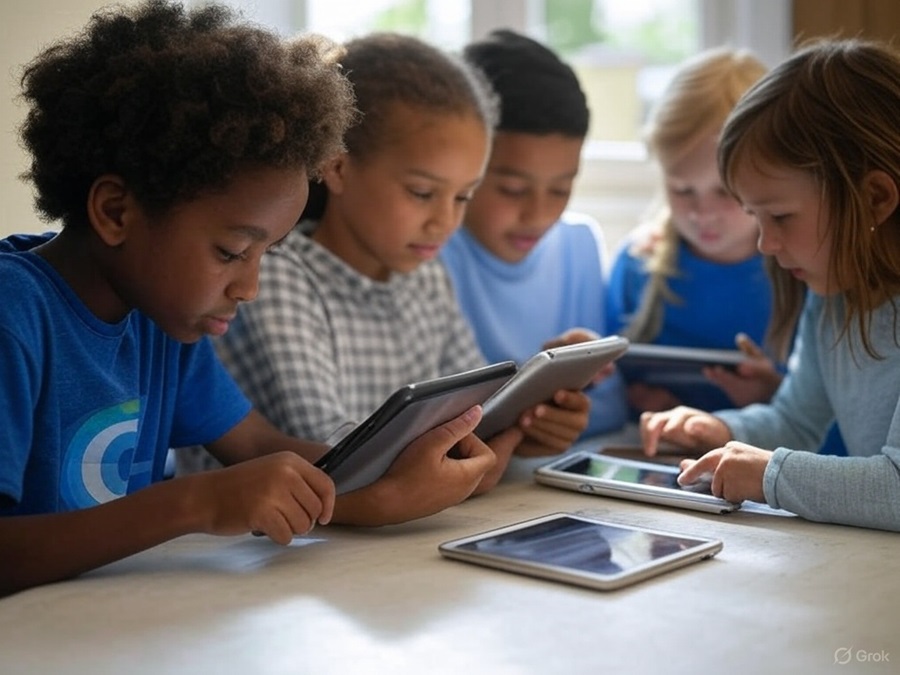- Psychology
- 11 de April de 2025
- No Comment
- 30 minutes read
Pamela Snow: “I am deeply concerned that we are engaging in uncontrolled experimentation with children”

Interview with Pamela Snow, Australian Speech Pathologist and Psychologist
Pamela Snow: “I am deeply concerned that we are engaging in uncontrolled experimentation with children”


Eva Serra / Xavier Massó
Pamela Snow is a Professor of Cognitive Psychology in the School of Education at La Trobe University (Bendigo campus, Australia). Holding a degree in speech-language pathology, she pursued a postgraduate qualification in Communication Disorders at the Lincoln Institute of Health Sciences (later incorporated into La Trobe University). She completed her PhD on acquired brain injury at La Trobe University and subsequently obtained a postgraduate certificate in higher education at Monash University. She became a registered psychologist in 2003.
Driven by a commitment to evidence-based teaching practice, her dual expertise in speech pathology and psychology significantly informs her research, which focuses on how language and literacy skills impact academic success and mental health, particularly in at-risk children and adolescents. Her current work explores the early transition from spoken language to literacy and the most effective ways to support this in early childhood classrooms.
Professor Snow actively engages in public research dissemination, particularly targeting parents, teachers, medical professionals, and policymakers through her blog, The Snow Report, where she breaks down evidence-based perspectives on reading instruction. She is also known for her critique of unsubstantiated educational interventions, such as the Arrowsmith Program. Having received multiple research awards, her reputation is built on a combination of rigorous scholarship, practical impact, and intellectual leadership, positioning her among the most prominent figures in cognitive psychology in Australia.
What do you attribute to the gradual decline in reading comprehension observed in many Western countries, as reflected in PISA and PIRLS reports?
First and foremost, I would argue that reading comprehension is the outcome of a vast array of influences, some of which may be quite distant in time. A portion of our ability to read stems from genetic, biological, social, and cultural factors—for instance, whether we grew up in a household surrounded by books and whether reading was encouraged or regarded as a valuable activity. Some of these factors are environmental, but others play a fundamental role in shaping the complex process of reading comprehension, particularly the type of reading instruction received.
“Regrettably, there is no single answer to the question of what is happening to reading comprehension. I believe we must concentrate on what is within our control, and the primary concern should be the educational environment and the quality of instruction”
For decades, English-speaking countries have been engaged in a heated debate about the most effective way to teach reading. Spanish, for instance, benefits from a more transparent orthographic and writing system; however, as is well known, English has a far more complex orthography. One of the strongest contributors to reading comprehension is children’s ability to decode words accurately and fluently. A study published—if I recall correctly, in 2023—by an international research team examined a generational cohort of over 3,000 Finnish twins. They investigated the relationship between early reading skills and reading enjoyment and found that competency must precede enjoyment.
The pandemic also had a significant impact on students, depending on their academic stage. Screens reduce both time spent on and focus dedicated to reading.
Whether it be smartphones, laptops, or tablets, these devices are inherently engaging and do not demand as much cognitive effort. Scholars such as Maryanne Wolf, an American scientist specialising in reading research, have convincingly argued that the time we spend reading on screens does not benefit our attention span.
Regrettably, there is no single answer to the question of what is happening to reading comprehension. I believe we must concentrate on what is within our control, and the primary concern should be the educational environment and the quality of instruction children receive. In my country, I do not believe there is sufficient consistency to ensure that reading instruction is delivered with the necessary pace, efficiency, and accuracy.
Reading is a biologically secondary skill that must be acquired through instruction. At what age do you think it is essential to begin structured and explicit reading instruction?
This is a complex question with many factors to consider. According to Professor David C. Geary, an evolutionary psychologist at the University of Missouri, education must take into account the distinction between biologically primary and biologically secondary abilities. Primary abilities are those that humans develop naturally with relative ease. Spoken language is a biologically primary skill. It is important to note that adults do not typically need to actively structure or promote the development of oral language in children. As a general principle, children will acquire spoken language, and unless there is some neurological barrier, they will learn to speak.
However, skills such as reading, writing, and spelling are abilities that our brains are capable of learning but we will not acquire them by osmosis, so to speak. A very small percentage of children may appear to learn to read fluently on their own, but as a general rule, biologically secondary skills require formal instruction—just like algebra or trigonometry. These are not skills that children absorb passively from their environment; they must be explicitly taught. Even something as seemingly basic as fractions must be instructed. Yet, unfortunately, the prevailing view in education since the 1970s and 1980s has been that reading is a natural process for children, which has influenced both instruction and teacher training regarding how reading should be taught.
“Stanislas Dehaene has conducted fascinating neuroimaging research showing that essential processes must occur in the immature brains of five-, six-, and seven-year-olds to establish the connection between speech and text”
I cannot speak for your country, but I can for mine: educators have not been adequately trained or provided with the necessary and specific knowledge about how the linguistic system works, what spoken language is, how oral language contributes to the transition to reading, writing, and spelling, and how we can effectively teach this biologically secondary skill. The French neuroscientist Stanislas Dehaene has conducted fascinating neuroimaging research showing that essential processes must occur in the immature brains of five-, six-, and seven-year-olds to establish the connection between speech and text. If this connection is not properly developed within the first three years of schooling, it becomes exceedingly difficult to remediate the knowledge gap later on.

What role should families play in this process?
This is a question that can provoke debate. In Australia, I believe there are sectors that place excessive responsibility on parents, to the extent that they are expected to ensure their children can already read before starting school. First, we must acknowledge that not all parents are literate in the language of instruction. In Australia, at least a quarter of the population is not native English-speaking and uses their own language at home—I believe your country is also highly multicultural. Therefore, we cannot assume that all parents have been educated in English, nor can we ignore the reality that some parents may be functionally illiterate.
In an ideal world, we would encourage parents to read to their children from birth. We want babies to hear complex language, to experience the joy of books, and to be transported to the rich worlds literature offers—its sophisticated vocabulary, intricate sentence structures, background knowledge, and all the elements we wish children to be exposed to. However, we must remember that this is not the same as teaching them to read. Just as playing Mozart sonatas for them does not teach them to play a musical instrument. I adore Mozart’s horn concertos, but playing them repeatedly will not teach children how to play the horn, even if it may help them develop a love and appreciation for music.
“I adore Mozart’s horn concertos, but playing them repeatedly will not teach children how to play the horn”
Ultimately, we welcome and encourage everything parents can do to support their children’s literacy development. However, we must also accept the responsibility of ensuring that schools provide education for all children, regardless of their starting point, linguistic background, or whether they come from chaotic and disadvantaged home environments. While we may not have direct control over those external factors, we do have the power to shape the educational environment within schools.
While reading is fundamental in primary education, some advocate for delaying its introduction, arguing that early childhood development should prioritise play, exploration, and social skills over formal academic learning. Based on your experience, how do you respond to this perspective?
I believe we should avoid binary thinking in this debate. In Australia, children typically begin school at around five years old, with most attending a preschool programme at four—and some even at three. There is widespread agreement that the early years should focus on developing oral language, social skills, sharing, turn-taking, empathy, imaginative play, and cognitive development. Young children should experience different environments in a safe and structured manner under the guidance of responsible adults. Play is central to childhood, and we should provide enriching environments that encourage it, as these aspects of development are biologically primary.
However, we can also integrate play with more intentional learning experiences in early education. For instance, if a preschool organises a dress-up day themed around different professions, providing children with role-related clothing and tools, it encourages them to acquire new vocabulary and knowledge. It is also beneficial to introduce concepts such as print awareness and name recognition. Many children become interested in recognising their own name in writing during the preschool years, and they can also begin to identify words related to professions or familiar places.
We know that knowledge of letter names and sounds is one of the strongest predictors of later reading success. Should we introduce formal reading instruction at the preschool level? No. However, are there opportunities to teach letter-sound correspondence, early numeracy, and foundational concepts in a playful, engaging manner? Absolutely. Doing so helps lay the groundwork for children’s future success in literacy.
To what extent is reading comprehension crucial for academic success?
There is a critical point to consider: when a 14-year-old student struggles with reading, they are not only excluded from accessing the curriculum but also often experience shame and disengagement from school. This has significant consequences for self-esteem, a sense of purpose, and optimism about the future.
“The importance of reading for academic and lifelong success cannot be overstated”
The importance of reading for academic and lifelong success cannot be overstated. In industrialised economies such as ours, low-skill jobs requiring minimal literacy and numeracy are disappearing rapidly due to advancements in artificial intelligence.
Take, for example, self-checkout systems in supermarkets. In the past, every transaction required interaction with a cashier who manually entered prices or scanned items. Now, in Australia—as I imagine is the case in Spain—self-service checkouts have become the norm. This reflects a broader shift in the workforce, where jobs for low-skilled workers are increasingly scarce, while opportunities for highly skilled workers expand.
The person who designs and installs the hardware for these self-checkouts is someone who succeeded in literacy, progressed academically, and likely obtained a university degree in computer science. In contrast, the individual working at the checkout may have left formal education early. This highlights a pressing social, economic, and civic concern: ensuring that all students develop strong reading and writing skills to participate fully in society and access meaningful employment opportunities.
Recent research underscores the importance of fostering three key levels of reading comprehension—literal, inferential, and critical—from the early years of education. Do you support this approach?
I am not specifically familiar with this classification of reading comprehension, but it seems to align well with our understanding of literacy development. Fundamental to early reading is literal comprehension—simply helping children decode the words on the page. This is what we mean by decoding: understanding that the symbols on a page correspond to spoken words.
“Fundamental to early reading is literal comprehension—simply helping children decode the words on the page”
If you handed me a page written in Arabic, I would recognise it as a written language containing meaningful words, but if I could not decode Arabic script, I would not comprehend anything. Mastery of the alphabetic code is therefore essential for understanding written text. From the outset, our goal is to develop literal comprehension by fostering automaticity and fluency in reading. We want reading to become an effortless process so that cognitive resources can be dedicated to deeper comprehension. We want children to reach as quickly as possible the point where their mental effort is directed towards comprehension.
Both English and Spanish make extensive use of figurative language, with regional variations in usage. In Australian English—both spoken and written—figurative expressions are a significant feature. Children must move beyond literal meanings to grasp phrases like it’s raining cats and dogs or describing someone as a dark horse. Fiction writers, in particular, employ figurative language extensively, compelling readers to infer meaning and engage more deeply with the text. This interpretative aspect is one of the reasons reading fiction is often so enjoyable.
When reading a physics textbook, for instance, we do not expect as much inference; the author is likely to explain concepts carefully, sequentially, and explicitly. However, when engaging with literature, newspapers, or opinion pieces, readers must draw inferences. At the highest level, critical comprehension involves evaluating a text, integrating prior knowledge, and assessing the accuracy, bias, or omission of information.
This framework provides a useful hierarchy for thinking about how we develop strong, independent readers.

In recent years, textbooks have been gradually phased out of classrooms. What impact might this have on curricular learning?
I do not consider myself an expert on this matter, but I believe it likely increases variability in what is taught and how it is taught. I am not convinced this is a positive development. The textbook publishing industry is undoubtedly a lucrative business, and it is fair to say that some profit from schools. However, I do believe that textbooks play an important role in education and in classrooms. They help ensure consistency between what is taught and what is learned, provide a level of accountability and transparency, and can also serve as a support for teachers.
“Well-structured textbooks, aligned with the curriculum, are valuable tools. Just as healthcare professionals rely on clinical guidelines in their work”
I do not think it is ideal for teachers to be staying up past midnight planning the next day’s lessons, downloading materials from the internet—sometimes of questionable quality—and hoping that what they find adequately covers a particular part of the curriculum. Well-structured textbooks, aligned with the curriculum, are valuable tools. Just as healthcare professionals rely on clinical guidelines in their work, we should implement evidence-based measures that facilitate the work of teaching professionals.
Do you consider a multidisciplinary approach—including pedagogy, linguistics, psychology, and journalism—important for fostering reading habits and engagement?
For early reading instruction, I would perhaps set journalism aside, but linguistics and psychology are undoubtedly fundamental, particularly through what we refer to as the science of learning. Linguistics, psychology, and pedagogy focus on how we structure learning tasks, whether through explicit instruction or discovery-based learning. These three disciplines, in particular, should inform educators’ understanding of the reading process.
Teachers need a solid grounding in cognitive psychology to grasp the complexity of reading acquisition in young brains. They must understand how working memory functions, how cognitive load theory applies, and that attention systems—especially in children—are highly fragile and easily overloaded. This is why we need to break new tasks and skills into manageable components, reinforce them, and revisit them repeatedly.
Linguistics is also crucial for teaching reading, and holds particular importance in English due to the language’s history and the influence of loanwords—including those from Spanish, I might add. As English has absorbed vocabulary from various sources, it has also adopted spellings that may initially appear unusual.
“Teachers need a solid grounding in cognitive psychology to grasp the complexity of reading acquisition in young brains”
Unfortunately, we sometimes hear teachers who lack an understanding of English’s linguistic history make statements such as: “English spelling is completely random”, “You can’t learn spelling rules in English”, “You just have to memorise how this word is written”. Such remarks are unhelpful, both in terms of conceptual understanding and teaching methodology. I therefore fully support a multidisciplinary approach to literacy instruction and to the way we prepare teachers for this critical task.

Sweden and the United States have reintroduced printed texts and handwriting lessons. What does cognitive science reveal about the gradual decline of handwriting instruction in many Western schools?
That is an excellent question. I believe we have underestimated the value of handwriting and are now paying a high price for doing so. Ample evidence in the scientific literature and cognitive psychology supports the idea that the physical act of writing letters and forming words plays a crucial role in the process of orthographic mapping—a concept introduced by Linnea Ehri. Research shows that when children learn to read, writing supports the long-term retention of a word’s appearance, spelling, sound, and meaning.
We also know that writing is cognitively more demanding than reading. Reading is a recognition task; writing is a retrieval task. Anyone who has learned another language knows that they may be able to read texts in that language but struggle to produce written content independently. This is certainly the case for me with French.
Schools that actively reflect on the connection between reading and writing—prioritising spelling, sentence structure, overall text construction and focus on cursive handwriting as a personal form of record-keeping —will help students much more effectively structure their writing.
If students do not know how to construct a proper sentence or fail to grasp that a grammatical sentence requires a subject and a verb to express a complete idea, their writing will be disorganised and chaotic. This is often evident among first-year university students who write as if they were speaking—whether on paper or on a computer screen—what is commonly known as a stream-of-consciousness style. They are unaware that written language follows its own register and conventions and that writers use tools such as punctuation to help the reader infer meaning.
“I am not aware of any compelling evidence suggesting that early access to iPads or laptops in classrooms has benefited children. I firmly believe that handwriting is far more beneficial than keyboard use”
For these reasons, I am a strong advocate for high-quality handwriting instruction and, at the same time, for removing digital devices from classrooms. I am not aware of any compelling evidence suggesting that early access to iPads or laptops in classrooms has benefited children. I firmly believe that handwriting is far more beneficial than keyboard use.
What is balanced literacy, and how can it be effectively implemented?
That is an excellent question too. My response, with a touch of humour, is that I have no idea—because balanced literacy has managed to elude any clear definition over the years. I am not entirely sure when this term was introduced into the field of reading instruction, but my understanding is that it gained traction after the U.S. National Reading Panel report was published in 2000. This was followed by a national literacy inquiry in Australia in 2005 and another in England in 2006.
The findings of these inquiries revealed that the Whole Language (WL) approach—widely promoted, endorsed, and adopted by English-speaking education systems—was ineffective in ensuring literacy success for the vast majority of children. In other words, it was leaving too many students behind.
So, in my view, what happened in response to these findings was a reluctant and somewhat begrudging acceptance that, indeed, children do need to learn how to decode, that phonics instruction is probably important, and that perhaps there had been an overemphasis on decoding alone. As a result, phonics was added into the mix, and the resulting cocktail was called balanced literacy.
However, the problem remains that there is no widely accepted definition of balanced literacy, which leads to an eclectic approach—one that fosters the idea of “I’ll do a bit of this and a bit of that… oh look, I have this book on my desk; I’ll read it to the children this morning”. But in practice, what happens is that balanced literacy relies heavily on levelled reading books from major publishers—such as the Fountas & Pinnell collection published by Heinemann—while placing little emphasis on teacher knowledge.
Earlier, you asked about the role of linguistics and psychology in shaping our understanding of reading instruction. The issue with balanced literacy is that structured teacher knowledge is sidelined and deemed irrelevant. We have evidence of this from Australia, the United States, and other English-speaking countries, showing that teachers are neither here nor expected to show up—because their expertise does not fit within how these systems operate.
Therefore, I believe that balanced literacy is an appealing and reassuring term—it sounds comforting and cleverly devised, but not much else.
“Therefore, I believe that balanced literacy is an appealing and reassuring term—it sounds comforting and cleverly devised, but not much else”
After all, who doesn’t want balance? We all want a balanced lifestyle, a balanced diet, and a balanced bank account. We want balance in everything. However, if we consider the opposite of balanced literacy, it would be structured, explicit instruction—delivered with clear scope and sequence by teachers who possess a deep understanding of the writing system they are teaching. So, I do believe balanced literacy is a failed experiment.
What is your assessment of approaches such as the aforementioned Whole Language (WL)? What long-term effects could they have on students? Based on the existing evidence, how can we strengthen the relationship between reading, writing, and oral expression?
I believe it was Reid Lyon, a literacy expert and developmental neuropsychologist in the United States (now retired), who coined the term “instructional casualties”. In my opinion, Whole Language (WL) and balanced literacy are responsible for producing a significant number of these instructional casualties—children who could have learned to read, write, speak, and spell proficiently but were not provided with high-quality instruction, particularly in their first three years of schooling.
In Australia, for example, the first year of formal schooling has different names in each state. In mine, it is called Foundation Year. This is followed by Year One and Year Two. Research shows that if a child reaches Year Three—that is, the midpoint of primary school—and is still not a competent reader, he has only a 20% chance of catching up. And this is only if they receive intensive, high-quality intervention. We also know that, in broad terms, addressing a reading difficulty in Year Four requires four times as many resources as addressing the same issue in Year One.
“Unfortunately, the balanced literacy model often leaves struggling readers without intervention, or when intervention is provided, here we go again”
Unfortunately, the balanced literacy model often leaves struggling readers without intervention, or when intervention is provided, here we go again—for example, more guided reading sessions—which do not actually address their underlying need to understand how spoken language relates to printed text. Instead, children are encouraged to guess, to look at pictures and, in fact, as many have observed, what we are doing when we’re teaching in that way is to teach the habits of struggling readers.
Without realizing it, we are instructing children how to become struggling readers rather than teaching them how to read proficiently.
I believe Whole Language and balanced literacy have a lot to answer for in this regard. However, I also think the real accountability lies with policymakers and education academics who have supported and perpetuated these approaches.

Could you explain the key principles of the “Five from Five” program?
When I hear Five from Five, I just want to make sure we are talking about the same thing. To me, it refers to a platform created in Australia over the last ten years. It was initiated by Jennifer Buckingham, a well-known reading scientist and advocate for education policy in Australia.
This platform is based on the so-called five big ideas that emerged from the U.S. National Reading Panel report in 2000. These five big ideas highlight the importance of phonemic awareness, phonics, fluency, vocabulary, and comprehension. The Five from Five website was created to provide parents and teachers—especially parents, who sometimes realize that the reading instruction their children receive is not as rigorous as it should be—with access to this information.
One of the main issues in Australia in recent years has been the inconsistency in reading instruction between schools, and even within the same schools. Until recently, even in my state, Victoria, each government school could decide on its own approach to teaching reading. Now that has changed, but only just this year.
Five from Five was designed to help parents navigate these challenges by providing high-quality, evidence-based information. In some cases, parents have used this resource to engage with their child’s school and advocate for different approaches to reading instruction. Unfortunately, some parents have also had to rely on this information to seek tutoring services when their children have fallen behind. So, in a way, it has become a knowledge translation platform.
How should children with reading and writing difficulties be supported?
In my ideal world, all children would receive explicit, structured, high-quality instruction delivered by teachers who have a deep understanding of their writing system. That is why we often talk about the three levels of instruction within a response-to-intervention framework.
Tier One is regular classroom instruction, which should meet the needs of 80–85% of students. Tier Two is small-group support, which may be necessary for 10–15% of students. Tier Three is individualized support, which might be required for about 5% of students.
If we assume that children receive high-quality instruction from the start, we should be using progress-monitoring tools to identify those who are beginning to fall behind. This is the first level of response, and the priority is early detection. Once identified, we should not introduce a completely different instructional approach. Instead, we should increase the dose of that same high-quality instruction in Tier Two and, if necessary, in Tier Three.
However, what sometimes happens is that children are initially taught using a balanced literacy approach. If they begin to struggle and fall behind, they then receive an explicit intervention focused on decoding—meaning they are suddenly being taught using a systematic synthetic phonics model, which is completely different from what they had been experiencing in the classroom. So, they spend time in a small intervention group where they are told, “This is how reading works”, only to return to their classroom and receive a completely different message about the reading process and what to do when they encounter an unfamiliar word. In my opinion, this only makes things worse.
Anita Archer, from the U.S., states that intervention should not be used to fix a Tier One problem. Instead, we need appropriate instruction in the general classroom and a continuous effort to improve it. If a small number of children still struggle, we must identify them early and provide them with the necessary intervention and support—not to teach them under an entirely different set of principles, but simply to increase the intensity of their instruction.
How do emerging technologies such as AI and digital screens impact literacy development?
I don’t think we fully know yet, and I worry about beginners using these tools. It’s one thing for us, as experienced readers and writers, to use an AI platform to synthesize or organize ideas—something we could do ourselves. But that is very different from what happens with beginners who have not yet developed those skills.
AI might be a great tool to support the development of literacy skills, but we know that reading and writing are difficult for children to learn. These skills require extensive instruction, support, and feedback. My concern is that we might stop explicitly teaching these skills because we assume students will simply use AI. They may gather fragmented, disorganized text and then rely on AI to fix it.
“I fear we may see a shrinking group of proficient writers within the population—while the rest will depend on AI”
That worries me because we could end up losing centuries of hard-earned literacy skills, and I fear we may see a shrinking group of proficient writers within the population—while the rest will depend on AI.
Maybe I’m a pessimist, but I’m not excited about the current educational outlook. I think education has developed a habit of prematurely adopting trends and ideas without waiting for solid evidence to back them up. That’s not how things work in medicine or healthcare, for example.
Think about clinical trials: new drugs and medical devices must undergo rigorous testing, pass multiple phases of trials, and be evaluated for potential risks before being made available to professionals. However, education has taken a completely different approach. I am deeply concerned that we are conducting uncontrolled experiments on children.
Source: educational EVIDENCE
Rights: Creative Commons

